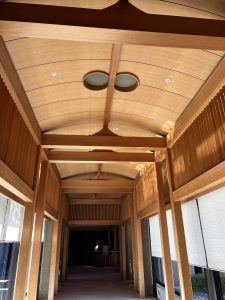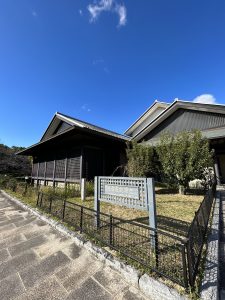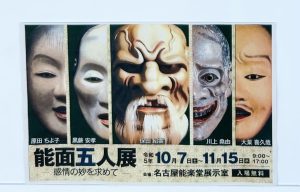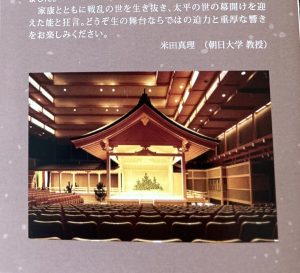未知の世界は魅力的です(名古屋市千種区姫池通 骨董買取 古美術風光舎)
2023.11.18
皆さまこんにちは。スタッフHでございます。
先日、病院の付き添いで出かけた際に数時間一人で時間を潰さなくてはならず、病院の向かいにある「名古屋能楽堂」を初めて訪れました。総木曽檜造りの国内最大規模の能楽堂です。


旅行は好きなのですが出不精な面もあり、たまたま通りかかったからという「ついで訪問」が多くなります。
能楽の知識はほぼない状態でしたが、深い沼の入り口を覗いてしまったようで、その伝統の世界に一瞬で魅了されてしまいました。
能楽(=能と狂言)は現存する世界最古の舞台芸術といわれています。ルーツは奈良時代に中国大陸から伝わった散楽という大衆向けの芸能です。散楽はやがて演劇的要素を取り入れた猿楽能へと発展します。室町時代には観阿弥、世阿弥親子が人気となり、3代将軍の足利義満の支援を受け、歌や舞を取り入れた優美な「能」を完成させます。
室町時代、能は武士の嗜むべき諸芸のひとつとなり、織田信長、豊臣秀吉、徳川家康も能楽の愛好家となり自ら好んで能を舞っていたとか。特に徳川家康は幼少の頃から能に親しみ、亡くなるまで能を愛し続けていたと伝えられています。
結婚式でよく聞く「たかさごや~」も「高砂」という能の演目のひとつで、武士の結婚式の席でうたわれていたようです。
さらに能と能の合間に滑稽なせりふ劇の「狂言」が演じられるようになり、同じ舞台で能と狂言が交互に演じられ現在の上演形態が出来上がったとされています。
「能」は歴史上の人物や物語を題材にした悲劇が多く、シテ方(主役)が面をかけて演じるのに対し、「狂言」は庶民の日常生活を面白おかしく描く喜劇です。
名古屋能楽堂では展示室などが無料で見学でき、私が訪れた日は愛知県在住の能面師による能面五人展が開催されていました。展示室に入ると壁にかけられた約40面の能面に圧倒され、一瞬足がすくむようなゾワッとする感覚がありました。

能面はヒノキで作られ、約200種類あり、その基本形は約60種で、主な面(おもて)は翁系の面、老人の面、鬼神の面、女面、怨霊のめん、男面、仏面などです。ひとつの能面は複数の異なる演目で使われることもあります。
室町時代から安土桃山時代に打たれた面を「本面」と呼び、その後はその基本形を写し(模倣)再現しています。経年変化したシミや傷も写しとるとか。能楽師は面に導かれるように役になりきって演じるとも言われています。そのため昔の面をそっくりそのまま写し、面の力を頂いて演じるそうです。
能面をつけて上を向くことを「テル」、下を向くとを「クモル」と呼び、無表情なはずの面が明るい表情に見えたり、悲しい表情に見えたり、能楽師のわずかな動きで様々な感情が表現できます。能面にはそうした能の本質である「包み隠す美しさ」が凝縮されているといいます。
名古屋能楽堂では、月に4回ほどガイド付きの無料の舞台見学会もあるそうです。美味しいレストランも併設されていますので、一度足を運ばれてみてはいかがでしょうか。

※パンフレットより
それでは、またお会いしましょう。
Hello everyone. This is Staff H.
The other day, I had to kill a few hours by myself when I went out to attend to a patient at the hospital, so I visited the Nagoya Noh Theater, which is across the street from the hospital, for the first time.
I like to travel, but I am also a lazy traveler, so I tend to visit places only because I happen to be passing by.
Although I had almost no knowledge of Nohgaku, I was instantly fascinated by its traditional world, as if I had peeked into the entrance of a deep swamp.
Nohgaku (= Noh and Kyogen) is said to be the world’s oldest existing performing art. The roots of Noh theater can be traced back to the Nara period (710-794), when it was introduced from mainland China as a form of performing art for the masses called sangaku. Sangaku eventually developed into Sarugaku Noh, which incorporated theatrical elements. In the Muromachi period (1336-1573), Kan’ami, Zeami and their son became popular, and with the support of Ashikaga Yoshimitsu, the third shogun, they perfected Noh, a graceful form that incorporated song and dance.
In the Muromachi period (1336-1573), Noh became one of the favorite arts of warriors, and Nobunaga Oda, Hideyoshi Toyotomi, and Ieyasu Tokugawa became lovers of Noh and loved to perform it themselves. Tokugawa Ieyasu, in particular, is said to have been familiar with Noh from an early age and continued to love Noh until his death.
The “Takasagoya” often heard at weddings is one of the Noh plays called “Takasago,” and was performed by warriors at weddings.
In addition, kyogen, a comical dialogue play, began to be performed between Noh plays, and it is said that Noh and kyogen were performed alternately on the same stage, thus creating the current form of Noh performance.
Noh plays are often tragedies based on historical figures or stories, and are performed with masks by the leading actors, whereas kyogen plays are comedies that amusingly depict the daily lives of ordinary people.
The Nagoya Noh Theater offers free tours of its exhibition rooms, and on the day I visited, there was an exhibition of five Noh masks created by Noh mask makers living in Aichi Prefecture. When I entered the exhibition room, I was overwhelmed by the 40 or so Noh masks hanging on the walls, and for a moment I had the creepy feeling that my legs were going to give way.
Noh masks are made of cypress wood and come in about 200 varieties, of which about 60 are basic forms. The main types of masks (omote) include masks of old men, masks of old men, masks of demons, female masks, masks of vengeful spirits, male masks, and Buddhist masks. A single Noh mask may be used in several different performances.
Masks struck from the Muromachi to Azuchi-Momoyama periods are called “hon-men,” and thereafter their basic forms are copied (imitated) and reproduced. Even age spots and scratches are copied. It is said that Noh actors play their roles as if guided by the masks. Therefore, they copy the masks exactly as they were in the past and perform with the power of the masks.
When a Noh mask is worn and the performer looks up, it is called “teru,” and when the mask is worn and the performer looks down, it is called “kumoru.” A mask that should be expressionless can appear cheerful or sad, and various emotions can be expressed with the slightest movement by the Noh performer. It is said that the essence of Noh, the “beauty of concealment,” is condensed in Noh masks.
Nagoya Noh Theater offers free guided tours of the stage about four times a month. It also has a delicious restaurant, so why not pay a visit?
See you again soon.
*******************
ご実家の整理やお片付けなどをされている方のご相談などが多くございます。
お片付けなどくれぐれもご無理のないようになさってくださいませ。
風光舎では古美術品や骨董品の他にも絵画や宝石、趣味のお品など様々なジャンルのものを買受しております。
お片付けをされていて、こういうものでもいいのかしらと迷われているものでも、どうぞお気軽にご相談下さいませ。
また風光舎は、出張買取も強化しております。ご近所はもちろん、愛知県内、岐阜県、三重県その他の県へも出張いたします。
まずは、お電話お待ちしております。
愛知県名古屋市千種区姫池通
骨董 買取【古美術 風光舎 名古屋店】
TEL052(734)8444
10:00-17:00 OPEN
#出張買取#骨董#古美術#骨董品#絵画#版画#茶道具#刀剣#彫刻

